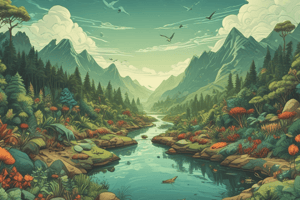Podcast
Questions and Answers
What is the smallest unit of an ecosystem?
What is the smallest unit of an ecosystem?
- Population
- Individual organism (correct)
- Community
- Species
What is the primary consequence of losing biodiversity?
What is the primary consequence of losing biodiversity?
- Increased ecosystem resilience
- Increased species interactions
- Loss of ecosystem services (correct)
- Increased population growth
What is the focus of population dynamics?
What is the focus of population dynamics?
- Variations in species interactions
- Shifts in community diversity
- Changes in ecosystem structure
- Changes in the number of individuals in a population (correct)
What is the ultimate goal of conservation biology?
What is the ultimate goal of conservation biology?
What is the term for the variety of life on Earth?
What is the term for the variety of life on Earth?
What is the primary goal of conservation biology?
What is the primary goal of conservation biology?
What type of interactions between species can have a negative effect on ecosystems?
What type of interactions between species can have a negative effect on ecosystems?
What is essential for maintaining biodiversity and ecosystem functions?
What is essential for maintaining biodiversity and ecosystem functions?
What is the study of the relationships between living organisms and their environment?
What is the study of the relationships between living organisms and their environment?
What is influenced by natural and anthropogenic changes?
What is influenced by natural and anthropogenic changes?
Flashcards are hidden until you start studying
Study Notes
Biology Ecology: Ecosystems, Biodiversity, Population Dynamics, Species Interactions, Conservation
Biology ecology is a field of study that explores the interactions between living organisms and their environment. It encompasses various subtopics, including ecosystems, biodiversity, population dynamics, species interactions, and conservation. These subtopics are interconnected and play a crucial role in understanding the functioning and sustainability of ecosystems.
Ecosystems
An ecosystem is a community of living organisms in conjunction with the nonliving components of their environment, interacting as a system. Ecosystems can be as small as a puddle or as large as the world's oceans. Understanding the processes that support population, community, and ecosystem dynamics is essential for sound management and conservation decisions.
Biodiversity
Biodiversity refers to the variety of life on Earth, including the variety of species, genes, and ecosystems. It is crucial to ecosystem functions and the ability to adapt to a changing world. The loss of biodiversity can have significant consequences, such as the loss of ecosystem services and the potential for species to become more vulnerable to threats.
Population Dynamics
Population dynamics focuses on the changes in the number of individuals in a population over time, including trends, stability, structure, connectance, diversity, and function. Population dynamics are influenced by various factors, including natural and anthropogenic changes. Understanding population dynamics is essential for conservation and management decisions.
Species Interactions
Species interactions refer to the relationships between different species in an ecosystem. These interactions can be positive (e.g., mutualism) or negative (e.g., competition or predation). Understanding species interactions is crucial for understanding the functioning of ecosystems and the consequences of biodiversity loss.
Conservation
Conservation biology is the study of the preservation of species and ecosystems. It encompasses various aspects, including the protection of endangered species, the restoration of habitats, and the management of human impacts on the environment. Conservation efforts are essential for maintaining biodiversity and ecosystem functions.
In conclusion, biology ecology is a multifaceted field that explores the relationships between living organisms and their environment. The subtopics of ecosystems, biodiversity, population dynamics, species interactions, and conservation are interconnected and play a crucial role in understanding the functioning and sustainability of ecosystems.
Studying That Suits You
Use AI to generate personalized quizzes and flashcards to suit your learning preferences.




